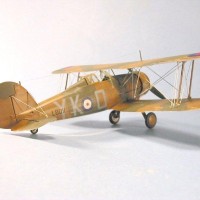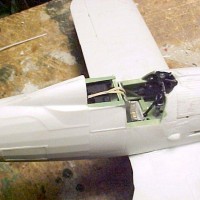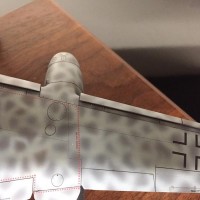Roden 1/48 Gladiator I
By the early 1930s, it was apparent to any aircraft designer that the day of the biplane was over: the inherent drag of the layout could not be overcome by any increase in performance, and the layout prevented the airplane from carrying a truly effective air-to-air armament.
While that was apparent in the design shops, it was not so apparent in the headquarters of most of the various Air Forces.Fighter pilots were still convinced that high-G maneuverability and a fighting style unchanged from that of 1917-18 was still what was needed. The Air Ministry had been "anti-monoplane" from the days of the Bristol M.1C, and there seemed little likelihood of this changing anytime soon.
Reality had begun to set in by 1930, at least in the RAF, with the issuance of specification F.7/30, which called for a single-seat fighter capable of 250 m.p.h. and carrying four rifle-caliber machine guns, which doubled the armament of all previous RAF fighters. The successful design was to be capable of both day and night operation, with particular stress on a wide field of view for the pilot and excellent landing characteristics. It was also hinted that "sympathetic consideration" would be given to designs utilizing the new steam-cooled Rolls-Royce Goshawk engine.
Fortunately for the RAF, the monoplane fighters that resulted from this competition were so thoroughly pedestrian that they failed to make the cut; had this been different, the RAF might have found itself in the position of the French Air Force in 1939 - trying to replace fighters that had been developed just too early to fully participate in the revolution of design that happened after 1934.
Amazingly enough, the winner of the competition that was supposed to result in the production of the service's first modern monoplane fighter, was the Gloster S.S.37, an evolutionary development of the Gloster S.S.19 - which was just being accepted into the RAF as the Gloster Gauntlet. The only acknowledgement to modernity of H.P. Folland's design was the use of hydraulically-operated flaps and an enclosed cockpit canopy - though the original prototype had been equipped with an open cockpit. In July 1935, the S.S.37 was ordered into production to specification F.14/35, with the name "Gladiator" - less than a year before the first flights of the Hurricane and Spitfire prototypes, and nearly a year after the successful first flight of the Bf-109V1 in Germany.
In the spring of 1937 - the same year that the Messerschmitt Bf-109 would commence operational deliveries to the Luftwaffe - the Gladiator was taken on charge by 72 Squadron at Tangmere.
Fortunately, within the next two years, the Gladiator would be almost completely replaced within Fighter Command by the Spitfire and Hurricane. At the outbreak of war in September 1939, only a few squadrons of the RAF and the R.Aux.A.F. were still equipped with the Gladiator in Great Britain.
However, in the next two years, the Gladiator would become one of the "immortals" of the Second World War. It was a fame derived from the heroism of those who flew it under difficult circumstances, not from any intrinsic value of the airplane. It was highly maneuverable, but - as RAF pilots in the Middle East would quickly discover after the entry of Italy into the war on June 10, 1940 - it was outperformed by just about everything it came up against.
Flying in desperate conditions in Norway in the spring of 1940, over Malta that summer, and over Egypt and Greece in the following twelve months, 13 Commonwealth fighter pilots would become aces with the Gladiator, and a total of 50 aces would obtain their initial victories in the little biplane.
Malcolm Thomas St. John Pattle:
"Pat" Pattle was the leading Gladiator ace, with 15.5 victories of his total of approximately 50, which makes him the leading ace of the British Empire in the Second World War. He served his entire career with 80 Squadron, RAF, which was also the leading Gladiator squadron in combat.
He first entered combat on August 4, 1940, when he and three other pilots led by future intruder ace Peter Wykeham-Barnes were assigned as escort for a 208 Squadron Lysander on a mission to photograph Italian positions near Bir Taieb el Esem. The foursome spotted and attacked a formation of seven Breda Ba.65s that attacked the Lysander, which were reinforced by their C.R.42 escorts. The four Gladiators quickly became involved in a dogfight. Wykeham-Barnes scored a Ba.65 while Kenneth Rew attacked another Ba.65 but was shot down and killed by the C.O. of the C.R.42s, Capitano Duilio Fanali. Wykeham-Barnes was also shot down but bailed out successfully.
Pattle and his wingman, Johnny Lancaster, attacked the second group of Ba.65s and Pattle downed one. Lancaster was hit by a C.R.42 and managed to crash land at Sidi Barrani, while Pattle shot down a C.R.42 and then escaped with only one gun still unjammed. He was then attacked by 12 C.R.42s and after a running fight in which his rudder controls were shot away, managed to bail out successfully as his Gladiator crashed. Both he and Wykeham-Barnes were rescued from the desert the following day by the 11th Hussars.
Pattle was described by a fellow pilot of 80 Squadron thusly: "A quiet, pleasant South African, he was a superb pilot, who was a better shot using deflection than any other member of the squadron."
Eventually transferring to the Hurricane during the battle against the Italian invaders in Greece, Pattle was promoted to Officer Commanding 33 Squadron on the occasion of being awarded his second DFC in March, 1941. On April 20, 1941, Pattle shot down two Bf-109Es, one Ju-88A-4, on Bf-100C, and a final Ju-88 over the Greek port of Piraeus, before he was shot into the sea by two Bf-109Es. He was just 25 years old.
The Roden kit was released in 2002 and can still be found, though long out of production. It's worth the effort and makes up into a good model OOB. There have been various upgrades issued over the years which do improve the kit. It's still the best 1/48 Gladiator out there (its competition being the ancient Merit kit, released many times by many others).


























Two wings, struts, wires and rigging...? I'll pass (yours turned out rather nicely, however).
Nice work Tom.
Very nice Gladiator, Tom. I remember this Iconic picture taken on Malta...
http://ww2today.com/2nd-april-1942-the-heroic-defence-of-malta
Nicely done Tom. What did you use for the rigging?
.012 wire
Thanks Tom
Haven't seen one of these for a long time. Your model looks great, Tom, although I'm not sure if my eyesight is up to the task of rigging. A quick check in the stash has revealed a Sea Gladiator, so it's now on the 'to do' list!
Don´t forget that Sweden sent quite a chunk of its fighter force to Finland against the Soviet forces. Crews were all volunteers and the Gladiator did a good job although this particular war, fought in Arctic conditions, was a fairly short one. After the Winter war Finland also used Gloster Gladiators.
There's a Roden release of the Gladiator II that does one of the Swedish volunteer airplanes, even has the skis. I have that somewhere in the stash.
In deed Roden did release a Gladiator with Finnish markings. Just be aware the black and white discs with skull and cross bones are from the return of the remaining aircraft to Sweden, not from the actual fightings (altough they do look cool and a bit pirate-ish). All remaining aricraft, Gladiators as well as Hawker Harts, got their Finnish hakaristi national roundels covered by figures and texts. Also note that the winter camouflage was sprayed aluminium dope , not white winter camouflage paint.
Thanks for that. "Piratical" sounds cool so...
Nice job, Tom. Good to see a Gladiator built.
It's one of life's pleasures to see a Gladiator done so well. Many of us in our distant youth were fascinated by the ops of Faith, Hope and Charity in defense of Malta before the Spits finally arrived. I always think it was a lovely a/c, however outlclassed it became. An interesting tale of Pat Pattle as well, something my BoB fetish had denied me. Great model! Paul
You've just demonstrated why I write those histories, Paul.
Outstanding work, Tom. I knew little of this great plane other than it served early in the war ... and was obsolete. I'll bet it was a joy to fly!
I talked to Stephen Grey when he was out at Chino to fly their newly-restored Hawk-75 and he said the Gladiator had "finger-light control."
Very sharp Gladiator Tom. Paint work and rigging look right on!
Nice build! Always liked the Gladiator’s aggressive look. I keep hoping Airfix will scale up its very nice 1/72 kit to 1/48.
You and me both!
Another nicely done model and post, Tom! Looks great.